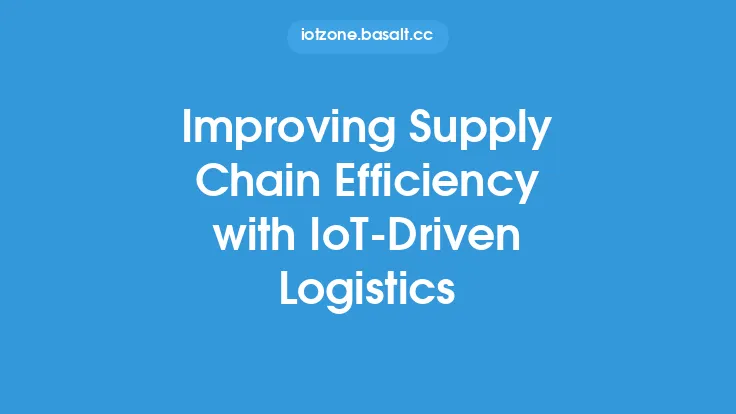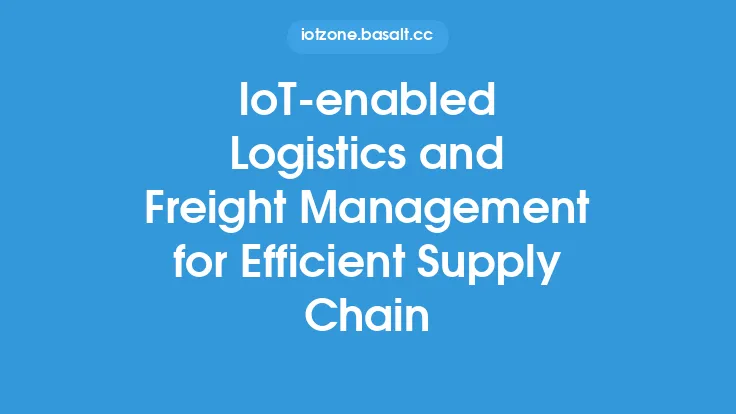The integration of Internet of Things (IoT) and Radio Frequency Identification (RFID) technology has revolutionized the way supply chain operations are managed. By providing real-time visibility and automation, these technologies have enabled businesses to streamline their supply chain operations, reduce costs, and improve efficiency. In this article, we will explore the benefits and applications of IoT and RFID technology in supply chain operations, and discuss how they can be used to improve the overall performance of the supply chain.
Introduction to IoT and RFID Technology
IoT technology refers to the network of physical devices, vehicles, home appliances, and other items that are embedded with sensors, software, and connectivity, allowing them to collect and exchange data. RFID technology, on the other hand, uses radio waves to communicate between a tag or smart label and a reader device, allowing for the identification and tracking of objects. When combined, these technologies provide a powerful tool for tracking and managing supply chain operations.
Benefits of IoT and RFID Technology in Supply Chain Operations
The use of IoT and RFID technology in supply chain operations offers several benefits, including improved visibility, increased efficiency, and reduced costs. With real-time tracking and monitoring, businesses can quickly identify and respond to issues, such as delays or inventory discrepancies. Additionally, IoT and RFID technology can automate many manual processes, such as inventory tracking and shipping, freeing up staff to focus on higher-value tasks.
Applications of IoT and RFID Technology in Supply Chain Operations
IoT and RFID technology can be applied in various ways throughout the supply chain, including:
- Inventory management: IoT and RFID technology can be used to track inventory levels, monitor stockroom conditions, and automate inventory reporting.
- Shipping and logistics: IoT and RFID technology can be used to track shipments, monitor cargo conditions, and optimize routing and scheduling.
- Warehouse management: IoT and RFID technology can be used to track inventory movement, monitor storage conditions, and optimize warehouse layout and operations.
- Quality control: IoT and RFID technology can be used to monitor product quality, detect defects, and track product genealogy.
Technical Requirements for Implementing IoT and RFID Technology
Implementing IoT and RFID technology in supply chain operations requires several technical components, including:
- Sensors and tags: These are used to collect data and track objects.
- Readers and gateways: These are used to communicate with sensors and tags, and to transmit data to the cloud or enterprise systems.
- Cloud or enterprise software: This is used to analyze and manage the data collected by IoT and RFID devices.
- Network infrastructure: This is used to connect IoT and RFID devices to the cloud or enterprise systems.
Best Practices for Implementing IoT and RFID Technology
To ensure successful implementation of IoT and RFID technology in supply chain operations, businesses should follow several best practices, including:
- Conduct a thorough needs assessment: This involves identifying the specific challenges and opportunities that IoT and RFID technology can address.
- Develop a clear implementation plan: This involves defining the scope, timeline, and budget for the implementation.
- Choose the right technology: This involves selecting the most suitable IoT and RFID devices, software, and network infrastructure for the specific application.
- Test and pilot the technology: This involves testing the technology in a controlled environment to ensure that it works as expected and to identify any issues or bugs.
Case Studies and Examples
Several businesses have successfully implemented IoT and RFID technology in their supply chain operations, resulting in significant improvements in efficiency, productivity, and customer satisfaction. For example:
- Wal-Mart: The retail giant has implemented an RFID-based inventory management system to track inventory levels and monitor stockroom conditions.
- Maersk: The shipping company has implemented an IoT-based tracking system to monitor cargo conditions and optimize routing and scheduling.
- DHL: The logistics company has implemented an RFID-based warehouse management system to track inventory movement and optimize warehouse layout and operations.
Conclusion
In conclusion, the integration of IoT and RFID technology has the potential to revolutionize supply chain operations by providing real-time visibility, automation, and improved efficiency. By understanding the benefits and applications of these technologies, and by following best practices for implementation, businesses can unlock significant improvements in their supply chain operations and achieve a competitive advantage in the market. As the technology continues to evolve, we can expect to see even more innovative applications of IoT and RFID in supply chain operations, leading to further improvements in efficiency, productivity, and customer satisfaction.




